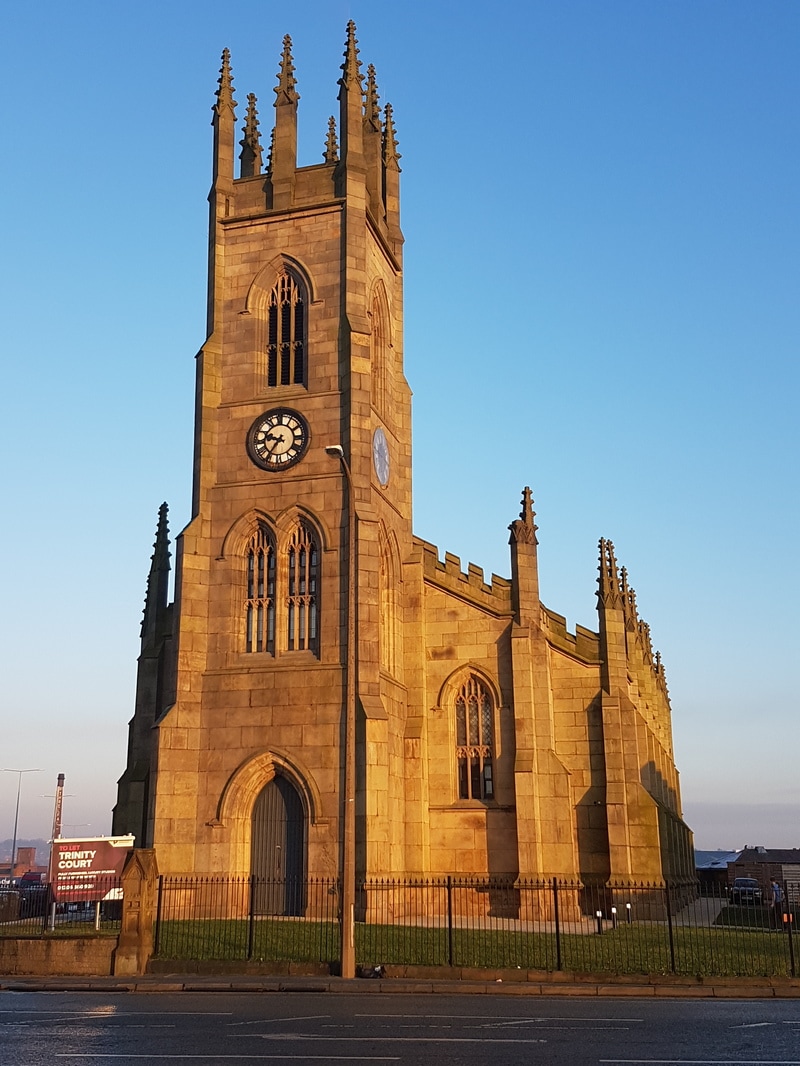Holy Trinity was designed by Philip Hardwick and built between 1823–25. A grant of £13,924 (equivalent to £1,030,000 in 2015) was given towards its construction by the Church Building Commission.
The church stands at the end of Newport Street, near the former Lancashire and Yorkshire Railway Station. The church is faced with ashlar stone and has a slate roof. It is a Gothic Revival building and has a seven-bay nave, a shallow chancel with a vestry to the east and a west tower.
The tower is in four stages with angle buttresses, it has a west doorway, above which is a pair of tiered windows. The third stage has clock dials, and in the top stage are three-light bell openings. The summit has pinnacles at the corners and at the midpoint on each side. The nave bays are separated by buttresses. These are topped by pinnacles which are linked by an embattled parapet. In each bay is a three-light tiered window. The chancel has a lancet window on the north and south sides, and a nine-light east window.
The ceremony of laying the corner-stone took place on 7 June 1823, the stone being laid by the Rev. Canon Slade, Vicar of Bolton. It was consecrated three years later on 11 September 1826.
The area around the church was originally considerably different to what it is today.
The church currently sits on the corner of two very busy main roads, to the West is a supermarket and retail park, to the North is a bus and railway station and to the East are railway lines. In 1826 the church was on a rise known as "Sweet Green." "a place of fragrant gardens and picturesque houses," as apparently noted by a contemporary writer. Immediately facing the west door was a thriving orchard and garden, the adjoining busy main road was a pleasant deep hollow of pastureland.
At that time the builders did not consider on the erection of a big new railway station which later was to cut away a large slice of the churchyard which was ultimately closed in 1856.
There is a story told of the Rev. M.F.Barton, who was vicar from 1849 - 1856. It is said he used to ride to church on a horse, tether it to the railings outside the church and enter the church and conduct the service still wearing his spurs.
The clock on the East side of the tower is considerably higher than those on the other sides. The reason for this is said to be due to a wealthy local resident who insisted on the clock on this side being elevated so that he could see the time from his bedroom windows. I imagine this persons house was located where the railway now runs or perhaps a bit further east where there are a number of other retail units alongside the main road into Bolton.
On 26 September 1915 at 12.20 am a German Zeppelin attempted to bomb Trinity St Station. The bomb fell short of its mark and crashed right through the roof of Trinity Church on the south side, fortunately the bomb did not explode but did leave a hole in the roof and a great deal of damage in its wake.
In 1919 the bells were recast and re-hung, but within a few days of their consecration a disastrous fire damaged the tower and completely ruined them.
The church was declared redundant on 1 July 1993 and has now been converted into apartments.

 RSS Feed
RSS Feed
